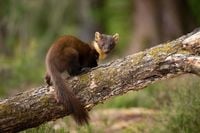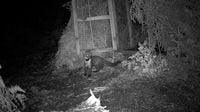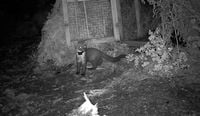For the first time in over a century, the elusive pine marten is once again roaming the woodlands of Exmoor National Park. In a landmark conservation effort that has captured the imagination of wildlife enthusiasts and local communities alike, nineteen pine martens—nine females and ten males—were released at secret locations across the park in September 2025. This carefully orchestrated reintroduction, led by the Devon Wildlife Trust as part of the ambitious Two Moors Pine Marten Project, marks a pivotal step in restoring balance to Britain’s fragile woodland ecosystems.
Pine martens, small predators about the size of a domestic cat, were once a familiar sight in the forests of southwest England. Their rich chocolaty brown fur and distinctive creamy, yellow to orange throat patch made them a striking presence among the trees. But by the early twentieth century, centuries of habitat loss, hunting, and trapping had driven them to local extinction. As Dr. Tracey Hamston, project lead for the Two Moors Pine Marten Project, put it to BBC News, “These animals were once a key part of our thriving woodland wildlife, so it’s good that they are back where they belong.”
The nineteen pine martens released on Exmoor were sourced from healthy wild populations in the Scottish Highlands, a region where the species has managed to persist. The journey south was no small feat: the animals were transported more than 500 miles in a specially adapted, temperature-controlled vehicle designed to keep them comfortable and safe. “We have licences to trap them in Scotland… we health check them, fit them with a tracking collar and bring them in a van with special adaptations,” Hamston explained. “We have to do welfare checks every three hours to make sure they’re looking bright and alert. So far both of our translocations have gone really well.”
Upon arrival in Exmoor, each pine marten was given its own release pen—a snug den box stocked with fresh food and water. The animals were allowed to acclimatize quietly for 72 hours before the doors were opened, giving them the freedom to slip into their new wild surroundings. Each was fitted with a lightweight, handmade leather radio collar, designed to drop off after six to nine months, allowing conservationists to monitor their movements and adjust management strategies as needed.
The project is a true collaboration, with Devon Wildlife Trust working alongside Dartmoor National Park Authority, Exmoor National Park Authority, Forestry England, National Trust, Somerset Wildlife Trust, and the Woodland Trust. Expert guidance from the Vincent Wildlife Trust has been instrumental, and the effort represents the culmination of up to seven years of planning, community engagement, and logistical groundwork.
This Exmoor release is the second major phase of the Two Moors Pine Marten Project. The first phase saw fifteen pine martens introduced to Dartmoor National Park in autumn 2024. That population has already shown signs of thriving, with the first births of kits—baby pine martens—recorded in July 2025. Conservationists hope that, in time, the Dartmoor and Exmoor populations will grow and merge, creating the first stable pine marten population in southwest England since the early nineteenth century.
Why go to such lengths to bring back this shy, nocturnal predator? Pine martens are considered a “keystone species” in woodland ecosystems. As generalist predators, they help keep populations of common and sometimes problematic species—such as grey squirrels, voles, and mice—in check. According to research cited by the Devon Wildlife Trust, pine martens are the UK’s only predator that can naturally control invasive grey squirrels, which have outcompeted native red squirrels across much of the country. “They definitely eat grey squirrels,” Hamston told The Guardian. “We’ve seen in other places such as Ireland and increasingly in Scotland that they can be a really big part of allowing red squirrels to come back.”
But pine martens do more than just hunt. Their varied diet includes wild fruits, especially in autumn, and as they move through the woods, they help spread seeds—supporting the regeneration of woodland habitats. Simon Larkins, National Trust general manager for Somerset coast and countryside, described the return of pine martens as “a truly special moment.” He added, “As a keystone species, pine martens play a vital role in woodland ecosystems, helping to create healthier habitats and supporting wider biodiversity. Their presence is a powerful reminder that when we give nature space and opportunity, recovery can happen.”
The reintroduction has not been without its challenges. Transporting wild animals over such a long distance requires meticulous planning and constant care. “Feeding blueberries to a wild pine marten in the back of a van is not an experience that I think many people will have. It’s amazing and a real privilege,” Hamston reflected. Once in their new home, the pine martens faced the task of adapting to unfamiliar territory, but the timing of the release—coinciding with the autumn abundance of wild fruits—was designed to give them the best possible start.
Pine martens are solitary and mainly nocturnal, spending time both in the trees and on the ground. Adults can live up to eleven years in the wild, weigh up to 1.8 kilograms (about four pounds), and reach lengths of up to 86 centimeters (including their bushy tails). Their semi-retractable claws make them exceptional climbers, and while they are generally not a threat to livestock or pets, poultry owners are advised to use predator-proof enclosures, as the animals are adept at scaling barriers in search of food.
Local communities have been encouraged to keep an eye out for these rare mammals. “If you manage to get a picture that’d be wonderful—do get in touch with us at Devon Wildlife Trust,” Hamston urged. The project team hopes that public engagement will help monitor the animals’ progress and build support for ongoing conservation efforts.
The Exmoor release is part of a wider national trend, with similar reintroductions having taken place in the Forest of Dean, Wales, and Cumbria in recent years. Each success story adds to the growing evidence that, with patience and collaboration, lost species can be restored to their rightful place in the landscape.
As pine martens slip quietly back into the woodlands of Exmoor, they bring with them the promise of a richer, more resilient ecosystem—one where the intricate balance of nature is given a chance to recover and thrive.






